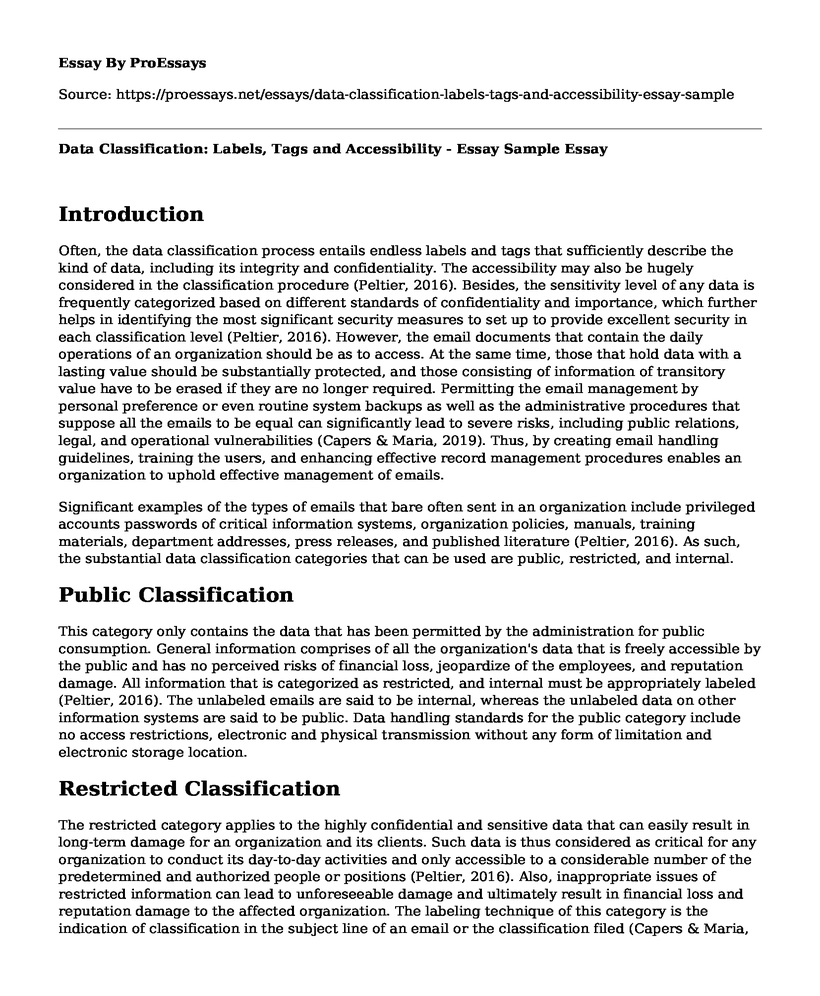Introduction
Often, the data classification process entails endless labels and tags that sufficiently describe the kind of data, including its integrity and confidentiality. The accessibility may also be hugely considered in the classification procedure (Peltier, 2016). Besides, the sensitivity level of any data is frequently categorized based on different standards of confidentiality and importance, which further helps in identifying the most significant security measures to set up to provide excellent security in each classification level (Peltier, 2016). However, the email documents that contain the daily operations of an organization should be as to access. At the same time, those that hold data with a lasting value should be substantially protected, and those consisting of information of transitory value have to be erased if they are no longer required. Permitting the email management by personal preference or even routine system backups as well as the administrative procedures that suppose all the emails to be equal can significantly lead to severe risks, including public relations, legal, and operational vulnerabilities (Capers & Maria, 2019). Thus, by creating email handling guidelines, training the users, and enhancing effective record management procedures enables an organization to uphold effective management of emails.
Significant examples of the types of emails that bare often sent in an organization include privileged accounts passwords of critical information systems, organization policies, manuals, training materials, department addresses, press releases, and published literature (Peltier, 2016). As such, the substantial data classification categories that can be used are public, restricted, and internal.
Public Classification
This category only contains the data that has been permitted by the administration for public consumption. General information comprises of all the organization's data that is freely accessible by the public and has no perceived risks of financial loss, jeopardize of the employees, and reputation damage. All information that is categorized as restricted, and internal must be appropriately labeled (Peltier, 2016). The unlabeled emails are said to be internal, whereas the unlabeled data on other information systems are said to be public. Data handling standards for the public category include no access restrictions, electronic and physical transmission without any form of limitation and electronic storage location.
Restricted Classification
The restricted category applies to the highly confidential and sensitive data that can easily result in long-term damage for an organization and its clients. Such data is thus considered as critical for any organization to conduct its day-to-day activities and only accessible to a considerable number of the predetermined and authorized people or positions (Peltier, 2016). Also, inappropriate issues of restricted information can lead to unforeseeable damage and ultimately result in financial loss and reputation damage to the affected organization. The labeling technique of this category is the indication of classification in the subject line of an email or the classification filed (Capers & Maria, 2019). In handling the restricted information, it cannot be transferred from the organization unless he approval from the information owners. The handling standards are, therefore, the electronic storage devices or database, encrypted electronic transmission, in house copying, and the destruction of the copies after use and the reading or view access by the information owner.
Internal Classification
Comprises of the non-sensitive operational data that is only accessible to the authorized service providers and the members of an organization. The information is generated or bestowed upon the organization by business partners or customers on mutual trust, whereby unauthorized access breaches the trust and adversely impacts reputation (Peltier, 2016). Data handling requirements for this classification include using the virtual private networks for the electronic transmission, access restrictions by the information owner, and electronic storage location apart from external web and FTP.
Information Systems Used in E-Mail Communication
Many information systems are applied in processing, transferring, storing, and the back up of E-mails. A significant example of such methods includes operational support and organization systems, which include portable computers through which the emails are created and delivered (Marie, 2010). Management reporting systems that ensure there is no email overload and that the emails are automatically sent ion exceptional circumstances or upon request by the information owner. However, for each of the information system, it is essential to be the information owner to be able to organize the data in various sensitivity levels and invest in data protection to prevent potential data leaks (Marie, 2010). Also, as the information system owner, the internet service provider has no right to access any email sent through their services since data security and confidentiality are my priority.
Conclusion
Conclusively, information may be classified for a variety of reasons, such as maintaining regulatory compliance as well as easier access. Data classification is, therefore, a process of organizing data in different vital categories with the primary intent of retrieving it more straightforward and enhancing its security efficiently.
References
Capers, Z. & Maria, G. (2019). "How to Select Data Classification Levels For your Business" GetApp.com. Retrieved from https://lab.getapp.com/data-classification-levels/
Marie, A. P. (2010). "Developing a Policy for Managing Email" Retrieved from http://www.archives.nysed.gov/common/archives/files/mr_pub85.pdf
McClure, C. R., & Sprehe, J. T. (2018). Guidelines for Electronic Records Management On State and Federal Websites. Washington, DC: National Historical Publications and Records Commission, National Archives and Records Administration.
Peltier, T. R. (2016). Information Security Policies, Procedures, and Standards: guidelines for effective information security management. Auerbach Publications.
Cite this page
Data Classification: Labels, Tags and Accessibility - Essay Sample. (2023, Mar 27). Retrieved from https://proessays.net/essays/data-classification-labels-tags-and-accessibility-essay-sample
If you are the original author of this essay and no longer wish to have it published on the ProEssays website, please click below to request its removal:
- Research Paper Example on Internet Addiction
- The Rise of Internet News Has Crippled the Print Media: Paper Example
- Big Data Analytics the Challenges and Opportunities
- How Cryptocurrency and Blockchain Technology Has Changed Business Essay
- How Did the Hackers Steal Target's Customer Data? Paper Example
- Essay Sample on Cyber Terrorism
- Essay Sample on Stuxnet: The First Weaponized Cyber Attack







